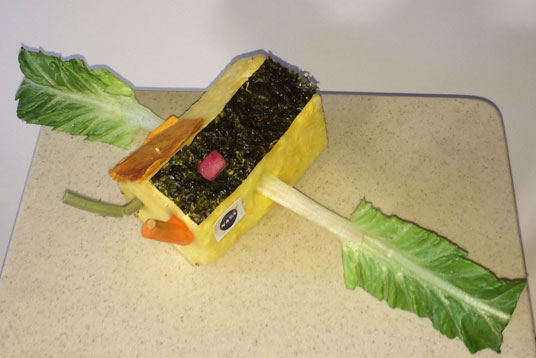Ask NASA Climate | June 4, 2014, 10:33 PDT
A taste of NASA

Edible model of OCO-2, NASA's soon-to-launch carbon-counting satellite.
Feast your eyes on my latest edible satellite model: NASA’s Orbiting Carbon Observatory-2 (OCO-2). Go ahead and laugh if you want—creating it was harder than it looks, and getting a decent photo was even more of a challenge. I created this food model to commemorate the upcoming launch (July 1, 2014) of NASA’s latest climate satellite, which will precisely monitor and map carbon dioxide in Earth’s atmosphere.
As with the model I created to pay tribute to the Global Precipitation Measurement (GPM) mission, this one was made of foods that I actually ate, so nothing went to waste. The radish and kale were harvested from my garden. The body of the satellite is a carved pineapple, the solar array is made from lettuce, the star tracker is a carrot, the vent pipe is a kale stalk, the instrument radiator is made of dried mango and the space blanket is dried kelp and radish. By looking closely at the instruments' designs to create the food model, I had to learn and understand more about this mission than I would merely studying a graphic or line drawing.
I encourage you to make your own NASA OCO-2 satellite model and to share your photos in the comments section. The spacecraft detail drawing is shown below, and you can learn about the OCO-2 mission and see more illustrations on the mission home page: http://oco.jpl.nasa.gov/.
I look forward to your comments and creativity.
Thanks for reading my blog.
Laura

OCO-2 is part of NASA's Earth Right Now campaign, a series of five Earth science missions that will be launched into space in the same year, opening new and improved remote eyes to monitor our changing planet.
